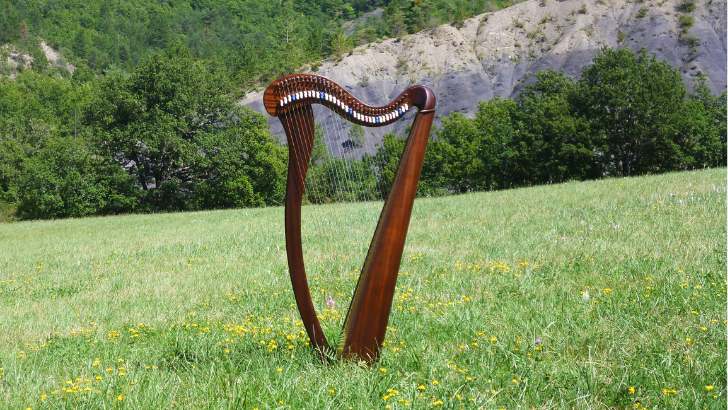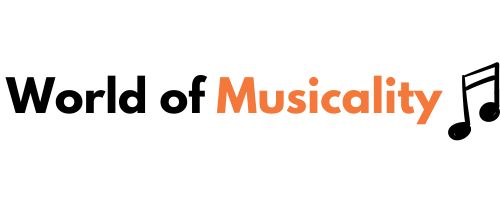
What is a Celtic Harp?
The Celtic harp is a triangular-shaped harp with a curved neck and a hollow resonating body.
It typically has between 22 to 38 strings, which can be made of gut, nylon, or metal.
The instrument is known for its bright, clear, and resonant sound. Also known as a Lever harp, the musician can vary its musical pitch by the changing of small levers at the top of the strings.
A harp player is called a harpist. In the context of traditional or folk music, the term “harper” is sometimes used, particularly in relation to the Celtic harp.
Detailed Celtic Harp Instrument Facts
| Instrument Name | Celtic Harp |
| Instrument Family | String |
| Alternative Names | The Celtic harp is known by different names in various regions. In Scotland, it is called the “Clarsach” or “Clàrsach.” In Ireland, it is referred to as the “Cruit” or “Cláirseach.” In Wales, a similar instrument is known as the “Telyn.” The collective name for this type of harp is a Lever harp. |
| Geographical Presence | The Celtic harp is played primarily in Ireland, Scotland, Wales, and Brittany. It is also popular in other countries with Celtic heritage and has gained international recognition. Harp festivals and competitions are held worldwide. |
| Instrument Classification | The Celtic harp falls under the Hornbostel-Sachs classification system as 322.221, identifying it as a plucked chordophone with strings which is manually tuned. |
| Unique Features | The Celtic harp is known for its distinct triangular shape, portability, and the use of levers at the top of the strings to change the musical pitch. Its size and design make it well-suited for solo performances, small ensembles, and accompaniment. |
| Sound Characteristics | The Celtic harp produces a bright, clear, and resonant sound with a rich harmonic texture. It can create a wide range of dynamics, from soft, delicate tones to strong, vibrant sounds. The instrument is known for its ability to produce fast, intricate melodies and arpeggios. |
| Typical Music Genres | The Celtic harp is primarily used in traditional Celtic music, including Irish, Scottish, and Welsh folk music. It is also used in classical, contemporary, and popular music genres, as well as in therapeutic music settings. |
| Components | Soundboard, Pillar, Neck, Strings, Tuning Pins, Levers |
| Construction | The Celtic harp is traditionally made of wood, such as maple, cherry, or walnut. The body consists of a soundboard, pillar, and curved neck. The strings are usually made of gut, nylon, or metal, and the tuning pins are made of metal. Some modern harps use synthetic materials for strings and levers. |
| Size and Weight | The size of the Celtic harp can vary, but they typically range from 0.75 to 1.2 meters (2.5 to 4 feet) in height. The weight varies between 4 to 10 kilograms (9 to 22 pounds), depending on the size and materials used. |
| Variations and Customizations | Variations of the Celtic harp include different sizes, numbers of strings, and types of levers for sharping. Customizations might include decorative carvings, inlays, and finishes. Some harps are designed for specific tunings or to be lightweight for travel. |
| Instrument History | The Celtic harp has origins dating back to ancient times, with evidence of its use in Ireland and Scotland as early as the 8th century. The instrument has evolved over centuries, with significant development during the medieval and Renaissance periods. It became an important symbol of Celtic culture and heritage and can be seen on many ancient artifacts such as coins, drawings and paintings. |
| Playing Technique | The harpist plucks the strings with their fingers, using both hands to create melodies, harmonies, and arpeggios. The levers are used to change the pitch of individual strings, allowing for chromatic notes. Proper hand positioning and finger techniques are essential for producing a clear and resonant sound. |
| Notable Composers | Turlough O’Carolan, John Thomas, William Mathias |
| Famous Works | O’Carolan’s “Si Bheag, Si Mhor,” Mathias’ “Sonata for Harp,” Thomas’ “The Minstrel’s Adieu to his Native Land” |
| Prominent Harpists | Derek Bell, Aine Minogue, Alan Stivell |
| Maintenance | Regular maintenance includes tuning the strings, adjusting the levers, and occasional string replacement. The wooden body should be kept clean and occasionally polished. Proper storage in a controlled environment is important to prevent damage from humidity and temperature changes. |
| Learning Difficulty | Moderate to high; requires coordination and finger dexterity to manage the strings and levers simultaneously. Learning proper hand techniques and music theory is important for effective playing. |
| Related Instruments | Pedal Harp, Paraguayan Harp, Gothic Harp |
| Tuning and Pitch Adjustment | The pitch of the Celtic harp is adjusted by tuning the strings to a specific scale, usually a diatonic scale. Levers are used to raise the pitch of individual strings by a half step, allowing for chromatic notes. Fine-tuning involves adjusting the tension of the strings. |
| Educational Resources | Resources for learning the Celtic harp include instructional books, online tutorials, music schools, and private lessons. Notable resources include “Sylvia Woods Harp Center,” “The Harp School, Inc.,” and various method books by renowned harpists. |
| Notable Harp Performances | Notable performances include the Edinburgh International Harp Festival, the Belfast Harp Festival, and concerts by prominent harpists at venues and festivals around the world. |
| Famous Orchestras/Bands | Prominent ensembles featuring the Celtic harp include The Chieftains, The Celtic Women, and various traditional Irish and Scottish folk groups. |
| How much is a Harp? | Celtic harps range from $500 to $5,000 or more, depending on the size, materials, and craftsmanship. Beginner models start around $500, while professional models with custom features can exceed $5,000. |
| Interesting Facts | 1. The Celtic harp is the national symbol of Ireland and appears on the country’s coins and official documents. 2. Turlough O’Carolan, a blind harper from the 17th century, is one of the most famous composers for the Celtic harp. 3. The oldest surviving harp in Ireland is the “Brian Boru Harp,” which dates back to the 14th or 15th century. 4. The lever harp, a modern variation, allows players to change the pitch of strings quickly and easily, making it more versatile for different music genres. 5. The Celtic harp is often used in music therapy due to its soothing and calming sound, which can help reduce stress and anxiety. |







